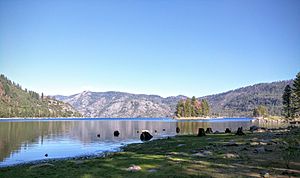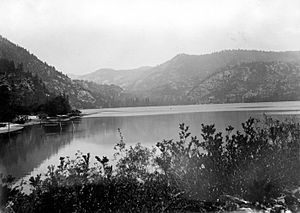Lake Eleanor facts for kids
Quick facts for kids Lake Eleanor |
|
|---|---|

Lake Eleanor's eastern shore in 2016, as viewed from a small peninsula
|
|
| Location | Yosemite National Park, Tuolumne County, California, United States |
| Coordinates | 37°58′41″N 119°52′45″W / 37.9779767°N 119.8790685°W |
| Type | reservoir |
| Primary inflows | Eleanor Creek |
| Basin countries | United States |
| Surface area | 953 acres (3.9 km2) |
| Water volume | 26,100 acre-feet (0 km3) |
| Surface elevation | 4,657 feet (1,419 m) |
Lake Eleanor is a large reservoir (a human-made lake) located in the beautiful Yosemite National Park in California. It sits high up in the mountains, about 4,657 feet (1,419 meters) above sea level. This lake is an important part of the Hetch Hetchy water system, which provides drinking water and electricity to the city of San Francisco.
Contents
Lake Eleanor's Geography
Lake Eleanor is found in a valley that was carved out by glaciers long ago. It sits at an elevation of about 4,600 to 4,700 feet (1,400 to 1,430 meters). Before the current reservoir was created, there was a smaller, natural lake here. This original lake was about 1.5 miles (2.4 km) long and 0.5 miles (0.8 km) wide.
Three streams fed the old lake: Kibbie Creek, Eleanor Creek, and Frog Creek. The valley floor used to be covered with a thick forest. This forest had many Jeffrey pine and ponderosa pines. You could also find Incense cedar, white fir, and California black oak trees. Smaller plants like Manzanita grew underneath the trees. Wet areas around the lake had willows and other marsh plants.
Lake Eleanor's History
In 1985, archaeologists studied the valley when the reservoir was drained for maintenance. They found signs that people lived in the valley a very long time ago, even before Europeans arrived. Because of the limited time and the muddy conditions, they couldn't fully explore how much the area was used.
European settlers started coming to the Lake Eleanor valley in the mid-1800s. By the late 1800s, two families claimed land here. Hermann Wolfe settled on the south shore, and Horace J. Kibbe settled on the north shore. Kibbe lived there until 1913.
Building the Lake Eleanor Dam
The Lake Eleanor we see today was created in 1918. This happened when a dam was built across Eleanor Creek. This dam was part of a much bigger plan called the Hetch Hetchy system. The goal was to provide water and electricity to the growing city of San Francisco. The original, smaller natural lake was also named "Eleanor." It was named after the daughter of Josiah Whitney, who led the California Geological Survey in the 1860s.
Lake Eleanor Dam Details
The Lake Eleanor Dam is a concrete dam with several arches. It stands 68 feet (21 meters) tall and stretches 1,260 feet (380 meters) long. Building this dam was the first step in the Hetch Hetchy project. It was designed to generate hydroelectric power all year round. The money earned from selling this power helped pay for the construction of the even larger O'Shaughnessy Dam, which was finished in 1923.
Opposition to the Dam
Building dams inside Yosemite National Park caused a lot of disagreement. One of the strongest groups against it was the Sierra Club. Their founder, John Muir, was a famous conservationist who fought hard to protect nature. Even after two vetoes by President Theodore Roosevelt, President Woodrow Wilson signed the Raker Act on December 19, 1913. This law allowed the dam construction to begin in 1914.
Unique Dam Design
Because the dam was in such a remote location, engineers had to use a special design. They chose a "multiple-arch" structure. This design used much less concrete compared to a traditional "gravity dam." What made it even more unique was that the concrete arches were elliptical (oval-shaped) instead of circular. This was the only multiple-arch dam ever built this way. Michael O'Shaughnessy, the chief designer for San Francisco, and R.P. McIntosh, a hydraulic engineer, were the main people behind this clever design.
Today, the city of San Francisco still owns and operates Lake Eleanor. It's a popular spot for fishing, hiking, and camping.
Climate
| Climate data for Eleanor Lake, California | |||||||||||||
|---|---|---|---|---|---|---|---|---|---|---|---|---|---|
| Month | Jan | Feb | Mar | Apr | May | Jun | Jul | Aug | Sep | Oct | Nov | Dec | Year |
| Record high °F (°C) | 75 (24) |
73 (23) |
79 (26) |
83 (28) |
87 (31) |
99 (37) |
101 (38) |
103 (39) |
98 (37) |
92 (33) |
80 (27) |
77 (25) |
103 (39) |
| Mean daily maximum °F (°C) | 47.1 (8.4) |
49.1 (9.5) |
53.5 (11.9) |
59.5 (15.3) |
66.2 (19.0) |
75.0 (23.9) |
85.3 (29.6) |
85.4 (29.7) |
79.4 (26.3) |
68.0 (20.0) |
57.9 (14.4) |
49.7 (9.8) |
64.7 (18.2) |
| Daily mean °F (°C) | 36.3 (2.4) |
38.1 (3.4) |
41.7 (5.4) |
47.7 (8.7) |
54.1 (12.3) |
61.7 (16.5) |
71.0 (21.7) |
70.3 (21.3) |
64.3 (17.9) |
54.0 (12.2) |
45.2 (7.3) |
38.9 (3.8) |
51.9 (11.1) |
| Mean daily minimum °F (°C) | 25.4 (−3.7) |
27.3 (−2.6) |
30.0 (−1.1) |
36.0 (2.2) |
41.9 (5.5) |
48.4 (9.1) |
56.7 (13.7) |
55.1 (12.8) |
49.1 (9.5) |
40.1 (4.5) |
32.4 (0.2) |
28.1 (−2.2) |
39.2 (4.0) |
| Record low °F (°C) | −7 (−22) |
−12 (−24) |
1 (−17) |
13 (−11) |
22 (−6) |
24 (−4) |
35 (2) |
34 (1) |
29 (−2) |
20 (−7) |
10 (−12) |
−2 (−19) |
−12 (−24) |
| Average precipitation inches (mm) | 7.71 (196) |
7.16 (182) |
5.93 (151) |
3.50 (89) |
1.91 (49) |
0.71 (18) |
0.09 (2.3) |
0.09 (2.3) |
0.51 (13) |
2.27 (58) |
4.17 (106) |
7.45 (189) |
41.5 (1,055.6) |
| Average snowfall inches (cm) | 30.3 (77) |
26.2 (67) |
32.2 (82) |
10.2 (26) |
1.6 (4.1) |
0.1 (0.25) |
0.0 (0.0) |
0.0 (0.0) |
0.1 (0.25) |
1.5 (3.8) |
6.7 (17) |
24.1 (61) |
133 (338.4) |
| Average precipitation days (≥ 0.01 in) | 10 | 10 | 10 | 8 | 7 | 3 | 1 | 1 | 2 | 5 | 6 | 9 | 72 |
| Source: Western Regional Climate Center | |||||||||||||




